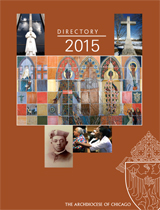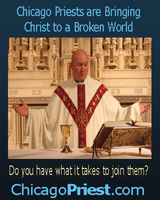You could call her the ‘pope’s U.S. photographer’

A regular feature of The Catholic New World, The InterVIEW is an in-depth conversation with a person whose words, actions or ideas affect today's Catholic. It may be affirming of faith or confrontational. But it will always be stimulating.
For some of us, seeing photos of the pope is as close as we will ever get to the successor to Peter. But for photojournalist Nancy Wiechec, getting close to the pope is part of her job. Wiechec is manager of visual media for Catholic News Service in Washington, D.C., and has photographed nearly every major papal trip since joining CNS in 1994. Her pictures have appeared in hundreds of Catholic newspapers and magazines as well as in several books on Pope John Paul II, Mother Teresa and Pope Benedict XVI.
She will also photograph Pope Benedict XVI’s trip to the United States this month. Wiechec gave an exclusive interview to The Catholic New World with editor Joyce Duriga and shared some behind-the-scenes moments of photographing one of the most photographed people in the world.
Catholic New World: What is one of the most challenging things about photographing the pope?

Nancy Wiechec, manager of visual media for Catholic News Service, photographing from the top of the Sydney Harbor Bridge in September 2007.
Nancy Wiechec: The most challenging part is gaining access to the pope and the events he leads. The pope is a hugely popular media figure. CNS has to compete for photo positions with all other news outlets, especially when covering events like a papal visit or World Youth Day.
Once you have access, the greatest challenge is coming up with a unique photo. He is one of the most photographed personalities in the world, capturing the pontiff at an unusual moment or in a different light is rare.
CNW: When starting out in your career, did you plan to work in the Catholic press and did you ever think you’d be photographing the pope?
Wiechec: My first major assignment out of college was photographing the visit of Pope John Paul II to Phoenix in 1987. I wanted to work for a secular newspaper but found myself interning at The Catholic Sun in Phoenix. I enjoyed the assignments so much that I continued in the Catholic press to this day.
I feel privileged to have a close-up view of how people live out their faith. And I believe religion and its impact on society is an under-reported story that deserves more attention.
CNW: What’s your favorite memory or moment of photographing Pope John Paul II? Pope Benedict XVI?
Wiechec: One of the most emotional moments for me was photographing John Paul II as he anointed the sick and those with disabilities during a Mass in Phoenix.
With Pope Benedict XVI, it was at one of his first weekly general audiences. I captured him, seemingly off cue, walking over to a woman in a wheelchair to grasp her hand (see photo below). These moments reminded me that even those in the top church position, are at heart called to do what all Christians are called to do — be present to the sick and those in need.
There are other memorable moments, that are not my favorites. One time I tripped in front of the popemobile as it was making its way through St. Peter’s Square. Luckily someone from the Vatican grabbed me by the elbow and helped me out of the way. I don’t know of any photojournalist who doesn’t have these embarrassing blunders.
CNW: You were there during the transition from Pope John Paul’s death through the installation of Pope Benedict XVI. What was the atmosphere like in Rome?
Wiechec: Up to election day it was very, very quiet in St. Peter’s Square even though thousands of people had gathered to wait for the moment. People were standing in the square for hours at a time with eyes set upon the Sistine Chapel’s smoke stack. Some were praying. (I guess if there was a role in the papal election for those who were not cardinals, that was it, praying that the right person be chosen.)
When the white smoke finally appeared, there was some confusion on people’s faces. Was the smoke white or black? I was not sure either, but kept on photographing people’s reactions. Then, I looked over to an Italian photographer I knew and she smiled and gave me a thumbs up. That’s when I knew the new pope had been elected. There was a thunder of noise from people clapping and cheering. Some people were crying.
CNW: You are witness to millions of peoples’ reactions to the Holy Father. What do you see or what do you feel when you look out into the crowds of faces during an audience?
Wiechec: Well there are all kinds of different reactions, but the ones that stick in my mind are those of the young people. Whether it be at a World Youth Day or in St. Peter’s Square there are always lots of teens and they are excited to be there.
They could be anywhere and yet they choose to be with their peers celebrating their faith. They seem to be looking for some sort of message from the pope that they can use to help them through life. I’ve seen young people walk away from events with John Paul II with this glow. Like someone just handed them the world to take as their own. It’s amazing, and I’ve been moved by those experiences.
CNW: You’ve been given a great gift, both in your talent and the service you provide to millions of Catholics. Do you think about this? What is the responsibility of a Catholic journalist?
Wiechec: What I think about most is doing the best job I can and getting the picture. But I am often surprised when a call or e-mail comes in to Catholic News Service from someone wanting a print of one of our pictures to hang in their home or office. I am glad to have taken a photo that has some meaning for them.
The responsibility of being a Catholic journalist I think is the same as being any journalist: Do your job with accuracy, fairness, with humility and as much as possible, with an unbiased view. It also helps a lot to know the faith. On that topic, I learn something new just about every day.
 Catholic
New World - Newspaper for the Archdiocese of Chicago
Catholic
New World - Newspaper for the Archdiocese of Chicago Archdiocese of Chicago Directory
Archdiocese of Chicago Directory Oficjalne wydawnictwo Archidiecezji Chicago w języku polskim
Oficjalne wydawnictwo Archidiecezji Chicago w języku polskim
